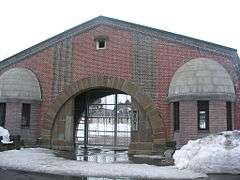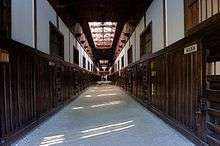Abashiri Prison
Abashiri Prison (Japanese: 網走刑務所, Hepburn: Abashiri Keimusho) is a prison in Abashiri, Hokkaido Prefecture that opened in 1890. The northernmost prison in Japan, it is located near the Abashiri River and east of Mount Tento. It holds inmates with sentences of less than ten years.[1] Older parts of the prison were relocated to the base of Mount Tento in 1983, where they operate as the country's only prison museum.
 | |

| |
| Location | Abashiri, Hokkaido Prefecture, Japan |
|---|---|
| Coordinates | 44°0′59.7″N 144°13′51.8″E |
| Status | Operational |
| Opened | 1890 |
| Managed by | Ministry of Justice |
History
In April 1890, the Meiji government sent over 1,000 political prisoners to the isolated Abashiri village and forced them to build roads linking it to the more populous south.[2] Abashiri Prison later became known for being a self-sufficient farming prison, and cited as a model for others throughout Japan.[2][3]
Most of the prison burned down in a 1909 fire, but it was reconstructed in 1912.[3] It took on its current name in 1922. In 1984, the prison moved to a modern reinforced concrete complex.[2]
The only man to escape the prison was Yoshie Shiratori in 1944, an antihero in Japan. Due to the 1965 film Abashiri Prison and its sequels, the prison became a popular tourist attraction.[2] The prison is also known for its wooden nipopo (ニポポ) dolls carved by its inmates.[4]
Museum

In 1983, older parts of the prison were relocated to the base of Mount Tento and operate as a museum called the Abashiri Prison Museum (博物館網走監獄). It is the only prison museum in the country.[2] As of 2016, eight of the buildings preserved at the museum are designated Important Cultural Property by the Agency for Cultural Affairs,[3][4] while three are registered Tangible Cultural Property.
In fiction
The Japanese manga series "Golden Kamuy" notably features the Abashiri Prison as one of its major plot points.
In the video game Yakuza 5 one of the protagonists, Taiga Saejima, escapes the Abashiri prison.
References
- "Inmates in Hokkaido raise beef cattle to learn about value of life". The Japan Times. 2015-06-23. Retrieved 2018-03-07.
- "Abashiri astounds with its ice and convict connections". The Japan Times. 2013-03-24. Retrieved 2018-03-07.
- "道内の文化財を訪ねて 旧網走監獄 静かに光差す舎房 /北海道" (in Japanese). Mainichi Shimbun. 2016-06-12. Retrieved 2018-03-07.
- "国の重要文化財指定へ!事務局長に聞く「博物館網走監獄」の楽しみ方" (in Japanese). Hokkaido Relations, Inc. 2015-12-29. Retrieved 2018-03-07.
External links
| Wikimedia Commons has media related to Abashiri Prison. |